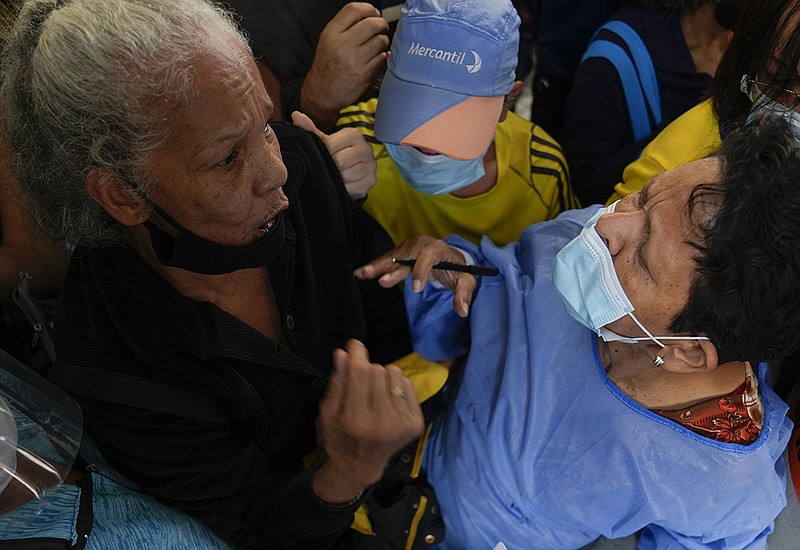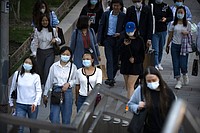Medical reports released this week suggest that the covid-19 pandemic has exacerbated vision problems and increased obesity rates among schoolchildren.
A report published Thursday in JAMA Ophthalmology is the latest to show the vision trend, and the results echo those of two earlier Chinese studies.
Researchers from Sun Yat-Sen University in Guangzhou compared data from eye exams given a year apart to about 2,000 children, starting in second grade. Half of the children were tested twice before the pandemic, in late 2018 and a year later. The others were tested in late 2019 and again late last year, several months after schools shut down and Chinese authorities imposed quarantines and lockdowns.
Initial tests of both groups done before the pandemic showed nearsightedness about the same -- about 7% of second-graders. It increased in both groups, but went up more in those retested late last year. By third grade, about 20% of them were nearsighted compared with 13% of those tested again before the pandemic.
[Video not showing up above? Click here to watch » arkansasonline.com/917bidenms/]
The study lacked information on how much time kids in both groups spent online or doing other work that might strain the eyes, a limitation the researchers acknowledged.
But a journal editorial said the results and those from earlier studies "should prompt parents, schools and governmental agencies to recognize the potential value of providing children with outdoor activity time and monitoring how much time is spent on near work."
Nearsightedness, formally called myopia, affects about 30% of the world's population, and evidence shows it has been steadily increasing over the past 20 years. It is an eye-focusing problem that makes distant objects look blurry and can often be corrected with eyeglasses. The condition can be inherited, but habits can affect who develops it. Evidence suggests that those who spend lots of time working at computers, reading or doing other close visual work are at risk.
Noreen Shaikh, a myopia specialist at Lurie Children's Hospital in Chicago, called the Chinese research solid and said Lurie researchers are investigating any changes in nearsightedness among U.S. children during the pandemic.
"Anecdotally, there definitely seems to be an increase -- particularly in younger children," Shaikh said.
[Video not showing up above? Click here to watch » arkansasonline.com/917unny/]
Her colleague, Lurie optometrist Magdalena Stec, noted that there are ways to help reduce eye strain, including lots of outdoor time and practicing the "20/20/20" vision rule -- after 20 minutes of focusing close-up, looking away for 20 seconds at something 20 feet away.
OBESITY INCREASE
In a separate study released Thursday, an "alarming" increase in obesity in U.S. children and teenagers has been seen during the pandemic.
Childhood obesity has been increasing for decades, but the new work suggests an acceleration last year -- especially in those who already were obese when the pandemic started.
The results signal a "profound increase in weight gain for kids" and are "substantial and alarming," said one of the study's authors, Dr. Alyson Goodman of the Centers for Disease Control and Prevention.
It's also a sign of a vicious cycle. The pandemic appears to be worsening the nation's longstanding obesity epidemic, and obesity can put people at risk for more severe illness after coronavirus infection.
The CDC on Thursday released the study, which is the largest yet to look at obesity trends during the pandemic.
[Gallery not loading above? Click here for more photos » arkansasonline.com/917covid19/]
It found:
• An estimated 22% of children and teens were obese last August, up from 19% a year earlier.
• Before the pandemic, children who were a healthy weight were gaining an average of 3.4 pounds a year. That rose to 5.4 pounds during the pandemic.
• For kids who were moderately obese, expected weight gain rose from 6.5 pounds a year before the pandemic to 12 pounds after the pandemic began.
• For severely obese kids, expected annual weight gain went from 8.8 pounds to 14.6 pounds.
The rate of obesity increased most dramatically in kids ages 6-11, who are more dependent on their parents and may have been more affected when schools suspended in-person classes, the researchers said.
The research was based on a review of the medical records of more than 432,000 kids and teens, ages of 2-19, who were weighed and measured at least twice before the pandemic and at least once early in the pandemic.
Some limitations: It included only children who got care before and during the pandemic, the researchers said. And it did not offer a look at how obesity trends may have differed between racial and ethnic groups.
Earlier this week, the CDC said the number of states in which at least 35% of residents are obese increased last year by four.
Delaware, Iowa, Ohio and Texas joined the list. In 2019, there were 12 states -- Alabama, Arkansas, Indiana, Kansas, Kentucky, Louisiana, Michigan, Mississippi, Oklahoma, South Carolina, Tennessee and West Virginia.
Those results were based on surveys where adults described their own height and weight, and are not as accurate as medical records.
MASKS RECOMMENDED
Many medical professionals are recommending that schoolchildren wear masks, noting that there is no scientific evidence showing that masks cause harm to kids' health despite baseless claims suggesting otherwise.
[CORONAVIRUS: Click here for our complete coverage » arkansasonline.com/coronavirus]
The claims are circulating on social media and elsewhere just as virus outbreaks are hitting many reopened U.S. schools -- particularly those without mask mandates.
Among the unfounded arguments: Masks can foster germs if they become moist or cause unhealthy levels of carbon dioxide. But experts say washing masks routinely keeps them safe and clean.
Some argue that young children miss important visual and social cues that enhance learning and development when their classmates and teachers are wearing masks. But others note that children with vision or hearing impairment learn to adapt and that other kids can, too.
"We don't know for sure that masks have no developmental effects but we do know that there are adverse effects from not trying to stop transmission," said Dr. Emily Levy, a critical care and infection control expert at Mayo Clinic Children's Center.
There's strong evidence that masking children in schools can reduce covid-19 transmission to other children and adults.
Across 166 schools in Maricopa County, Ariz., covid-19 outbreaks are two times more common at those without mask mandates, said Dr. Rebecca Sunenshine, medical director of the county's public health department.
Studies from school districts in other state, including North Carolina, have also found that masking can greatly reduce covid-19 transmission rates, especially when it's combined with physical distancing and other prevention measures.
"One thing that we know about prevention, about infection control is that there isn't a single intervention that will win the day," said Dr. Joshua Schaffzin, director of infection prevention and control at Cincinnati Children's Hospital.
But he noted there's plenty of evidence that masking is a key component in making schools safer.
To avoid skin irritation, doctors suggest washing masks regularly, making sure they fit properly and picking masks made with soft, breathable fabric.
LINGERING HEALTH EFFECTS
A new study has found that 1 in 3 people who survived covid-19 suffers from long covid.
The study of Long Beach residents published by the U.S. Centers for Disease Control and Prevention on Thursday found that these long covid patients reported at least one symptom of covid-19 two months after first testing positive for the coronavirus.
There were higher rates of long covid among people 40 or older, women, people with preexisting health conditions and Black residents, according to the study, conducted by the University of California, Davis epidemiologists and the Long Beach Department of Health and Human Services.
The survey was based on the responses of 366 adults in Long Beach who tested positive for the virus last year, before vaccinations were authorized for emergency use and began to be rolled out to health care workers.
The study found that 35% of survey responders reported at least one ongoing symptom of covid-19 two months after the initial positive test.
Fatigue was reported by 17% of those long covid patients; difficulty breathing and loss of taste or smell were reported by 13%; and muscle or joint pain was reported by 11%.
The study authors said the results are important to help experts "develop efforts to prioritize prevention and treatment strategies for" populations at higher risk of long covid.
The study was published in the CDC's Morbidity and Mortality Weekly Report.
Information for this article was contributed by Lindsey Tanner and Mike Stobbe of The Associated Press; and by Rong-Gong Lin II and Luke Money of the Los Angeles Times (TNS).


